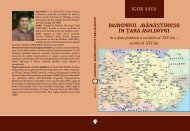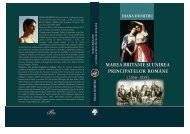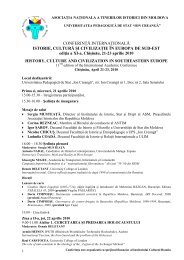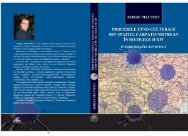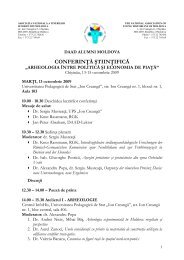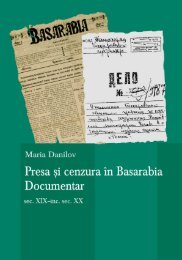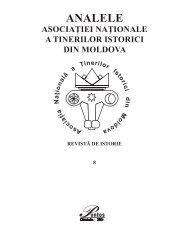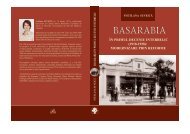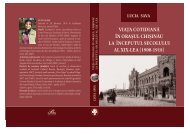aici - Asociatia Tinerilor Istorici din Moldova
aici - Asociatia Tinerilor Istorici din Moldova
aici - Asociatia Tinerilor Istorici din Moldova
You also want an ePaper? Increase the reach of your titles
YUMPU automatically turns print PDFs into web optimized ePapers that Google loves.
În acest manual, informațiile despre evenimentele<br />
petrecute în anul 1812 sunt integrate în contextual<br />
internațional al epocii, însă prezentarea şi explicarea<br />
evenimentelor este una foarte restrânsă.<br />
Prin urmare, în manualele de după 1989,<br />
informaţiile referitoare la evenimentele petrecute în<br />
anul 1812, care au avut consecinţe dramatice pentru<br />
populaţia <strong>din</strong> teritoriul anexat de Rusia, sunt destul de<br />
puţine. Cauzele, contextul şi urmările acestor evenimente<br />
nu sunt prezentate şi explicate aproape de loc,<br />
excepţie făcând poate manualul unic apărut imediat<br />
după 1989.<br />
SUMMARY<br />
THE YEAR 1812 IN ROMANIAN TEXTBOOKS, BEFORE AND AFTER 1989<br />
Due to their important functions, their complexity and<br />
diversity of contents, textbooks represent an indispensable<br />
element for each society. Accor<strong>din</strong>g to Wolfgang Höpken,<br />
textbooks nowadays are in competition with other massmedia<br />
devices and, very often, they have few chances to<br />
gain a student’s mind. Even the most sophisticated textbook,<br />
didactically speaking, written in order to promote<br />
peace and harmony loses its power in front of a computer<br />
game meant to prepare a child for a virtual war game.<br />
Mirela-Luminița Murgescu considers textbooks to be<br />
“a means of transport of an ideology, of a system of values,<br />
of a memory, of an identity, which is changed by the society<br />
from a common object into vivid reality”. The textbook<br />
is a kind of “Bible”, of “holy book” which helps students<br />
to interact with both the past of their country and other<br />
nations’ history. However, the way in which textbooks<br />
present a certain event or phenomenon and, also, their<br />
structure depend on the curriculum and on the way in<br />
which the author or the authors understand to integrate<br />
the historical information. Although the textbook seems<br />
a closed work, full of certitudes to which one should not<br />
ask questions, it is, in fact, “a means of transport of an<br />
ideology, of a memory, of a national identity”. Finally, the<br />
textbook is a social product with an educational role. The<br />
History textbook – in particular – answers to some social<br />
rules. It transmits the uniform, accepted, and even the official<br />
version of what the students should know about the<br />
history of their nation.<br />
From the diversity of textbooks, the History ones have,<br />
or better said, had a special character, being transformed<br />
in a kind of “business card”. The history textbooks insist<br />
on some major themes – the origins and the archetypal<br />
symbols, the continuity in the same space, the connections<br />
between the Romanian people and the unity. In addition<br />
to this, the last theme treats the moment 1812 which was<br />
and still is a subject of great interest in the academic area<br />
and not only. The year 1812 can be considered a sort of lieu<br />
de la mémoire of Romania’s national past.<br />
We do not intend to speak about school books, but, it<br />
must be mentioned the fact that textbooks have a specific<br />
writing, a certain conception, depen<strong>din</strong>g on the level of<br />
the scientific information and also on the pedagogical and<br />
didactic features characteristic for the period in which they<br />
are written.<br />
In the interwar period, after Basarabia’s integration in<br />
Romania without having Bolshevik Russia’s consent, the<br />
textbooks maintained the lessons about the the Russo-<br />
Turkish War (1806-1812) and Basarabia’s loss. Even if the<br />
textbooks’ authors did not analyse these events in as many<br />
pages as Tocilescu and Xenopol did before the First World<br />
War, the moment of Basarabia’s kidnapping is well represented<br />
in textbooks.<br />
However, the war’s end brought a major change – a<br />
fracture in fact – as far as the interpretation of the events<br />
from 1812 is concerned. During the communist period,<br />
the history became “instrumentum regni”, serving the<br />
communist ideology. In this respect, the year 1812 and<br />
the peace in Bucharest are presented in textbooks accor<strong>din</strong>g<br />
to the Soviet vision over Romania’s past. Therefore,<br />
in 1812 Russia released Basarabia from the Ottoman occupation,<br />
contributing in this way at the development of this<br />
country even if Tsar’s government was a “retrograde” one.<br />
The distance between Bucharest and Moscow and also the<br />
adoption of the national communist line by Ceaușescu had<br />
a strong impact on the manner in which the national past<br />
was presented in history textbooks. Thus, the main changes<br />
in history textbooks concerning the year 1812 consist in<br />
the explication of the term Basarabia as “part of Moldavia<br />
between Prut and Nistru” and the fact that Russia “incorporated”<br />
Basarabia.<br />
The analysis of the way in which the moment 1812 is<br />
presented in the textbooks printed after 1989 can be made<br />
in the context of the evolution of the historical education<br />
in Romania after the fall of communism. The Romanian<br />
society have not debated yet the school’s role in one’s<br />
education and life, even if the multitude of crisis in the<br />
educational system brought into public attention several<br />
problems regar<strong>din</strong>g this topic.<br />
To conclude, there is little information concerning<br />
the events that took place in 1812, whose consequences<br />
were dramatic especially for the population in the territory<br />
annexed by Russia who suffered a process of Russification.<br />
These events’ causes, context and consequences are very<br />
shortly presented and explained, with the exception of the<br />
only textbook printed immediately after 1989.<br />
– 337 –



